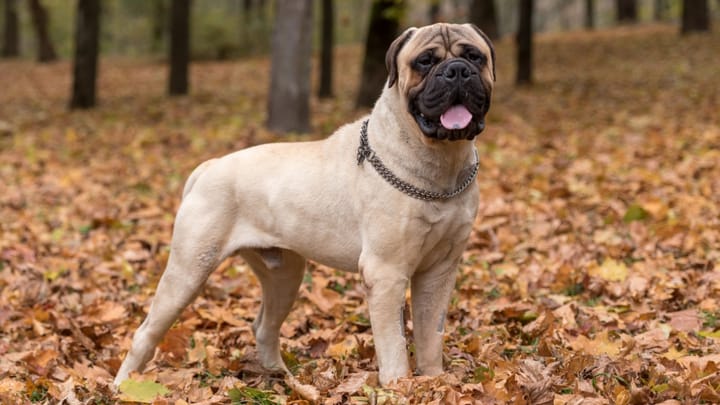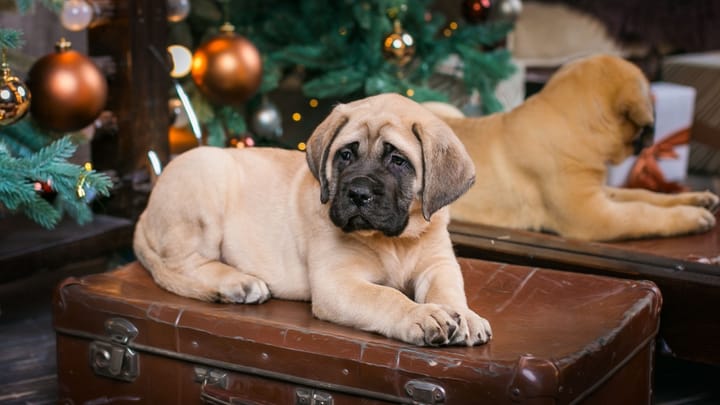Bullmastiff


The Bullmastiff is a powerful, active, reliable and resilient watchdog. They are very versatile and can play the role of a guardian, a police dog, a companion dog or a show dog. Confident, sure of themselves and very courageous, they make a very faithful breed who are attached to their friends and need social interaction to flourish.
|
Life expectancy |
The Bullmastiff has a life expectancy of between 8 and 10 years |
|
Size |
Large
|
|
Adult size |
Female
Between 24 and 26 in
Male
Between 25 and 27 in
|
|
Adult weight |
Female
Between 90 and 110 lb
Male
Between 110 and 130 lb
|
|
Coat colour
The coat can be all brindle, tawny or fawn. The most important thing is that the colour is pure and clean. A white mark on the chest is acceptable but any other markings are considered a defect. The mask is black and must fade to the eyes. |
Red |
|
Type of coat
The coat is short. The hair is hard to the touch and lying flat. The hair should neither be long, nor silky or woolly, as this does not correspond to the official standard of the breed. |
Short Hard |
|
Eye colour
The eyes are either dark or hazel. Clear or yellow eyes are not to standard. |
Brown
|
|
Purchase price |
The Bullmastiff costs between £540 and £900 |
The Bullmastiff is the ideal breed for those who love big dogs but do not have enough space to accommodate a real giant. Their balanced character makes them a reliable dog in all situations, but first-time owners should beware not to be attracted solely by their magnificent physical characteristics.
More details about the Bullmastiff
Bullmastiff: Origins and history
The Bullmastiff is the result of a cross between the Mastiff and the Bulldog. The intention of first crossing of these two breeds was only to create fighting dogs, both powerful and flexible in nature. However, when official battles came to an end (in 1853), people realised that crossing these two breeds could create a new pure breed with good qualities. Forest rangers were particularly interested: they needed a flexible, powerful dog with a flair for fighting against poachers. Pure breed selection began in the 19th century and was perfected in the late 20th century by S. Moseley, who is considered the creator of the modern Bullmastiff.
Physical characteristics of the Bullmastiff
The Bullmastiff is a dog with a strong, symmetrical and powerful structure; but not heavy. Their head is that of a catch dog; their skull must be strong and square. The perimeter of the skull should be equal to the height at the withers. The muzzle is short: the distance between the tip of the nose and the stop is about one third of the total length of the head. The skull-face axes are convergent, and the stop is well marked. The eyes are either dark or hazel, medium-sized, set far apart and separated by a wrinkle. The ears, V shaped or folded backwards are set wide and high on the back of the head. The definition should be strong, with large, separated canine teeth. Clipping with scissors or pliers is allowed: a slightly protruding jaw is allowed but not sought after. The legs are strong and muscular.
FCI classification of the Bullmastiff
-
Group 2 - Pinscher and Schnauzer - Molossoid and Swiss Mountain and Cattledogs
-
Section 2 : Molossian type
Bullmastiff: Characteristics
Bullmastiff: Behaviour
Training a Bullmastiff
They are not the most docile dogs, but their desire to please their masters encourages them to be cooperative if the relationship is based on trust and mutual respect.
A lot of patience and consistency will be needed to get the best results with this dog who, in any case, will never be a perfectly obedient dog. They will always need a little time to think before obeying their master.
However, a clear advantage of this breed is their very good memory. In fact, everything they learn will stay with them for life.
Moreover, given their great size, it is advised to start training as soon as the Bullmastiff puppy arrives home. Life rules and educational bases must be established quickly to prevent any bad habits setting in early.
At first, call-back and walking on a lead without pulling will need to be acquired quickly in order to, on the one hand, keep control over this dog and, on the other hand, to ensure the walk is a pleasant experience.
The help of a professional obedience training and behaviour is desirable.
Bullmastiff: Lifestyle
Breed compatibility Bullmastiff
Bullmastiff: Purchase price
The price of a bullmastiff varies according to their origin, age and sex. On average, they cost around £900 for a pedigree dog.
Regarding the monthly budget required for their maintenance (food and conventional care included), it’s estimated at around £60 a month.
Bullmastiff: Shedding
Average
Hair loss is moderate but intensifies during moulting periods, which occur in Autumn and Spring. Brushing it on a daily basis will be required in order to get rid of the dead hair.
Bullmastiff: Grooming
Maintaining the Mastiff’s coat is not complicated, brushing it a few times a week is enough to preserve the beauty and protective quality of their coarse-haired coat.
Bullmastiff: Health
Life expectancy is estimated at around 9 years.
The Bullmastiff, like many other dogs in this category, is hardy and of a solid structure.
Their slightly flattened nose may prevent them from regulating their body temperature as efficiently as other dogs. In fact, the heat is not a very comfortable experience for this Mastiff.
During the summer months, it’s best to adapt walk times to the weather, so either early in the morning or late at night.
This dog’s short, coarse hair gives them good protection from bad weather but only to a certain, reasonable limit.
This dog is sufficiently robust but should not be allowed to put on more weight: as they’re very greedy, it’s necessary to create a suitable feeding arrangement with the breeder and then the vet. Deviating from this arrangement is not advisable, even in the face of yearning pleas from the most insistent dog.
- Cancer (lymphoma)
- Gastric dilation syndrome/ torsion
- Heart disease
- Hip and elbow dysplasia






